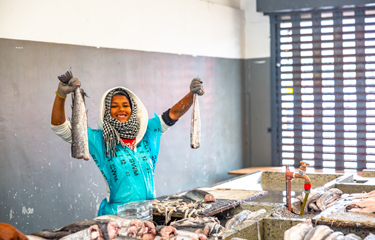Demand for seafood products in the Middle East and Africa has been rising steadily, a trend that is likely to persist through 2027, according to a new report from Insight Partners, a venture capital and research firm based in New York City, U.S.A.
The report, “Middle East and Africa Seafood Market Forecast to 2027 - COVID-19 Impact and Regional Analysis,” found the value of the seafood market in the two regions is projected to grow from USD 9.3 billion (EUR 7.7 billion) in 2019 to USD 10.7 billion (EUR 8.9 billion) in the next six years.
Rising seafood per capita consumption, increasing demand for imported seafood products, and the emergence of specialty seafood restaurants are some of the factors anticipated to drive market growth in the regions, according to the report. And an anticipated continued growth of seafood consumption in the two regions will be the primary expansion driver, Insight Partners found.
“Improvement in economic conditions and gradual increase in disposable income levels will also complement market growth,” the report said.
Africa’s economic growth is estimated at 3.4 percent for 2019 and 2020, according to the African Development Bank, which projects the growth to increase to 3.9 percent in 2021. The growth is expected to expand the continent’s middle class, giving them more disposable income, which may accelerate that income group’s increasing preference for premium seafood products.
The Insight Partners report also cites growing urbanization as one of the biggest drivers in growth of the seafood market in both the Middle East and Africa, with demand surpassing supply, requiring a surge in imported products to plug the deficit. The report mirrors projections by other agencies, such as the Food and Agriculture Organization (FAO) and the Organization for Economic Cooperation and Development (OECD), which point to urbanization as a key driver shaping consumption trends, especially in Africa. The OECD estimates Africa’s urban population rose to 567 million in 2015 from 27 million in 1950, giving the continent one of the fastest urban growth rates in the world. The OECD further predicts Africa’s population will double by 2050, with 75 percent of the growth “absorbed by urban areas.”
Growth in urbanization “has shaped the nature and extent of fish consumption in many countries,” according to the FAO in the 2020 edition of The State of World Fisheries and Aquaculture.
“Urban inhabitants typically have more disposable income to spend in animal protein such as fish, and they eat away from home more often,” FAO said. “[Furthermore], infrastructure in urban areas allow for more efficient storage, distribution, and marketing of fish and fish products.”
The rising number of households with discretionary spending in Africa could underpin faster growth of the region’s consumer market according to Deloitte. The business advisory firm estimated the number of Africans with a capacity for discretionary spending on seafood at 375 million, or 34 percent of the continent’s population.
That population is increasingly looking toward imported product to meet its demand. Africa imports up to 35 percent of the fish consumed in the continent due to “solid demand, including that for non-locally produced species in the face of static or declining domestic fish production” according to FAO.
“African fish imports, mainly affordable small pelagics and tilapia, present an important source of nutrition, especially for populations that are otherwise dependent on a narrow range of staple foods,” FAO said.
In the Middle East, Saudi Arabia is emerging as the major player in the region’s seafood market. Saudi Arabia’s imports and exports of fish and fishery products has “been on an increasing trend in recent years,” according to the FAO. FAO estimates the country’s seafood imports to reached USD 633.1 million (EUR 522.2 million) by 2015, compared to USD 100 million (EUR 82.4 million) in exports.
An additional 300,000 tons of seafood products is expected to be produced in South Arabia by 2035 after four companies merged to boost the country’s fisheries sector. The merger, involving aquaculture companies Jazadco, Tabuk Fisheries co., Aquaculture Sharq Farms Company, and Tharawat Seas, with a total market value of SAR 500 million (USD 133.2 million, EUR 109.8 million), is designed to eventually create “the world's leading company in fish and shrimp farming sectors through operating integrated farms,” according to the Saudi Arabia Ministry of Environment, Water, and Agriculture.
As part of the announcement, completed last January, the new firm, now known as Advanced Aquaculture Company, hopes to produce 60,000 metric tons (MT) of seafood in its first phase of growth, 120,000 MT in its second stage, and 300,000 MT by 2035.
Photo courtesy of Finn stock/Shutterstock







